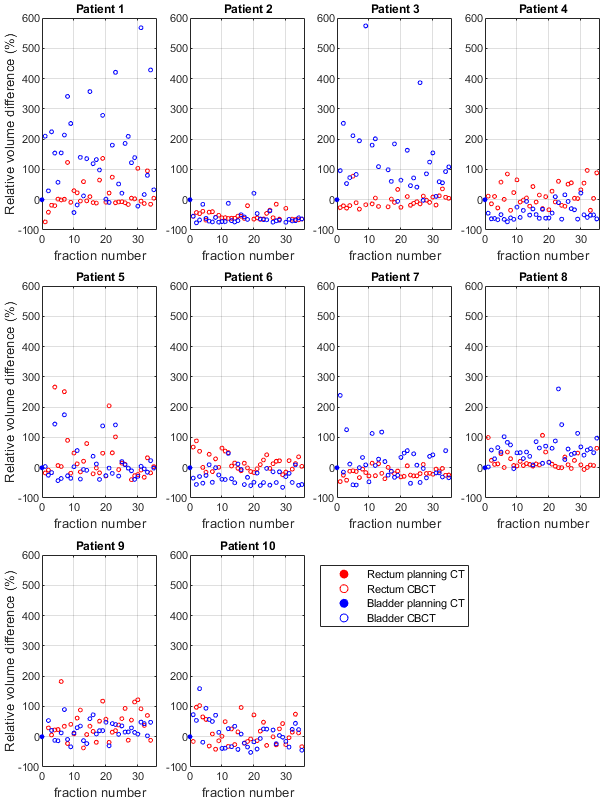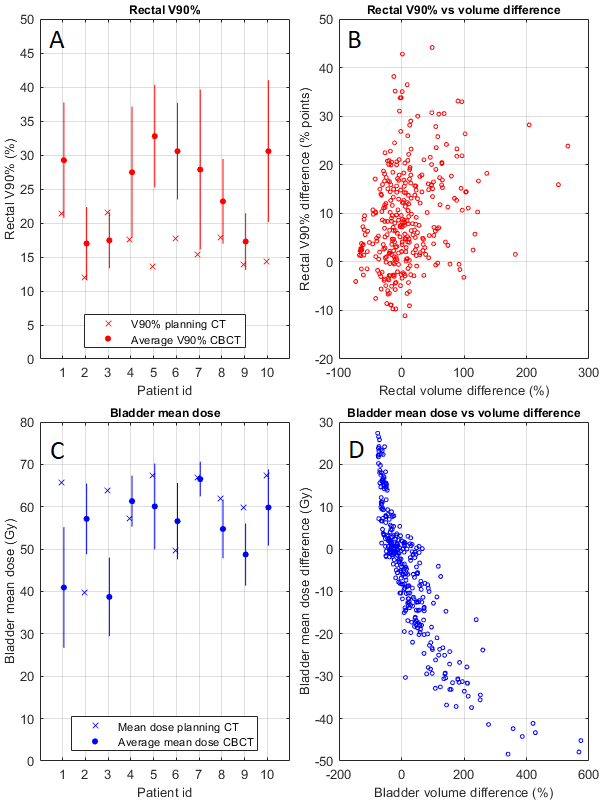Inter-fraction variability of rectum/bladder volumes and doses based on daily CBCT imaging
PO-1373
Abstract
Inter-fraction variability of rectum/bladder volumes and doses based on daily CBCT imaging
Authors: Thomas Henry1,2, Niclas Pettersson1,2, Ulrika Lindencrona1,2, Ariadni Kyriakogiannaki3,4, Andriana Giouroukou3,4, Jon Kindblom3,4, Karin Braide3,4
1Region Västra Götaland, Sahlgrenska University Hospital, Dept of Medical Physics and Biomedical Engineering, Gothenburg, Sweden; 2Institute of Clinical Sciences, Sahlgrenska Academy, University of Gothenburg, Department of Medical Radiation Sciences, Gothenburg, Sweden; 3Region Västra Götaland, Sahlgrenska University Hospital, Dept of Oncology, Gothenburg, Sweden; 4Institute of Clinical Sciences, Sahlgrenska Academy, University of Gothenburg, Department of Oncology, Gothenburg, Sweden
Show Affiliations
Hide Affiliations
Purpose or Objective
To evaluate the daily variation in rectum and bladder volumes over the course of a postoperative prostate RT treatment and the impact on the delivered organ doses.
Material and Methods
10 consecutive patients receiving postoperative RT for prostate cancer (2.0 Gy x 35) were included in this study. An initial patient setup was performed using orthogonal planar kV images matched on bony structures. For each patient, daily CBCT images of the pelvic region were then acquired. The CBCT study was not used to setup the patient before treatment.
Rectum and bladder, including their content, were delineated on the CBCTs according to local guidelines. They were copied to the planning CT (pCT) according to the patient position after kV setup and their volume variations over the treatment course were assessed. Assuming that the dose distribution from the treatment plan was not affected by the changes in anatomy, we evaluated the dose distribution variations using the relative rectal V90% and bladder mean dose.
Results
Image data were missing for 11 out 350 fractions; we evaluated rectum and bladder variations in 339 CBCT studies (n =30-35 per patient).
Around half of the 339 reviewed CBCTs presented a rectum volume variation of at least ±20% and a bladder variation of at least ±50%. No general trends were observed in the volume variations over the treatment course, Fig. 1. Compared to the pCTs, the average volume variation over all CBCTs for rectum was +8%±47% and +26%±94% for bladder, one standard deviation. Similarly, the maximum volume variations overall were +266%/-73% for the rectum and +574%/-76% for the bladder.
The overall (n=339) average difference in rectal V90% was 9±10 percentage points (pp). The overall average bladder mean dose variation was -5±15 Gy. Per-patient data are summarized in Fig. 2A & C. The relationship between volume difference and dose/volume differences are shown in Fig. 2B & D. As expected, the bladder mean dose was inversely correlated to the bladder volume. Such trend could however not be identified for the rectum. For studies where the rectal volume difference was within ±5%, the range of V90% differences were -5/+43 pp.

Fig 1. Per patient variations of rectum and
bladder volumes over the treatment course.

Fig 2. A & C: per-patient average rectal
V90% and bladder mean dose from daily CBCTs (± 1 SD) compared to the planning CT. B & D: per-study relationship (n=339)
between volume difference and rectal V90% difference (B) / bladder mean dose
difference (D).
Conclusion
Rectum and bladder volume variations were found to be substantial for all patients. The rectal V90% variation was found to be high independently of the rectum volume variation. This could indicate that not only the rectal volume but also its position possibly plays a role in how much dose is delivered to the rectum at each fraction. This could in return advocate for considering daily matching on CBCT images, especially in cases where the target is localized directly on the anterior wall of the rectum.